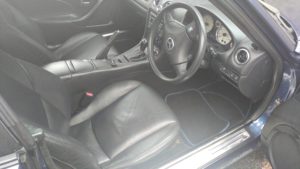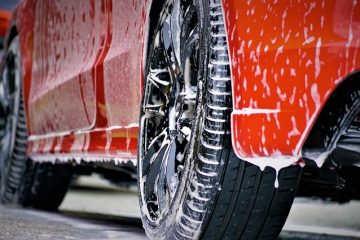Prestige Mobile Car Valeting Aberdeen.
Machine Polishing is a method of Polishing a vehicles paintwork by using a rotary buffer and/or a dual action polisher.
The aim of a machine polish is to reduce minor swirls (light scratches and spider web type damage) and in some cases returning the paintwork to factory spec.
Swirls and scratches are particularly visible on black coloured vehicles which are highly visible in the sunlight.
At Prestige Valeting we employ the following steps:
1. The vehicle is washed and dried using high-quality microfibre cloths and then filtered and heated air is used around door handles and crevices to ensure the vehicle is completely dry.
2. The vehicle is then clay barred to remove paint imperfections.
3. A soft polishing pad and a light compound are used at first to asses the hardness of the vehicles clear coat. Depending on the hardness more aggressive pads and polishing compounds are employed to reduce the number of swirls and scratches.
4. The vehicles paintwork is then protected with a high-quality paint sealant.
5. If the vehicle’s interior is to be detailed all fabrics and carpets have a high-quality sealant applied.
6. Instructions on how to wash the car to prevent further damage are also given as well as the best products to use.
Prices are dependent on the size of the vehicle and whether the interior is to be detailed as well.
For all inquiries and a free quote contact Prestige Mobile Car Valeting on 07828210041.
An in-depth method for Machine Polishing
Polishing with a machine reveals more opportunities compared to polishing manually, simply because products are often worked much harder as well as a lot longer effortlessly. By way of example, a lot of well-known dual action machine polishers has a nice maximum working speed of approximately 6000 orbits every minute. It’s always impossible for a human being to duplicate the job rate; consider aiming to polish the panel in a rounded action 6000 times a minute for five minutes or higher, on a regular basis making use of continuous pressure. Mainly because the work rates are additionally selectable, machine polishers can be used to properly undertake just about all sorts of paint defects, including mild swirl marks to extremely profound scratch marks. The only real proviso is that the clear coat has to be intact before you start, and must not be lowered to lower than 78% of your original thickness because of polishing. An additional benefit from polishing by the machine during large work rates is the fact that painted areas may be burnished a great extremely excessive lustre ahead of the putting on sealant or maybe wax protection; the exact same level of quality of finish is incredibly hard to obtain while working personally.
Even though machine polishing delivers several benefits over operating yourself, in addition, it provides intricacy to the polishing approach. This is because extra selections must be made with consideration to machine kind and also pad selection. A lot of these choices are essential since if you get them incorrect it’s very all too easy to destroy ones paint; machine polishers can easily get rid of paint amazingly easily if not applied effectively. Let’s start with the selection of machine kinds. Machine polishers get caught in 1 of 2 camps; rotary or dual motion. Rotary polishers are usually the range of professional detailers. Since the title implies, the actual polishing head moves consistently around a hard and fast stage from speeds as much as 2499 cycles each minute. The following rounded action produces a lot of friction which they can use to great advantage whenever solving major paint faults. Yet, the down-side in this would be that it is likewise very easy to create harm by means of burn spots. Mastering the ability of rotary polishing takes a great number of practice.
Dual action machine polishers get the job done very differently to rotary polishers, for the reason that the polishing head oscillates at random about a set position as the polishing head spins (hence the term dual action). What this means is that friction is without a doubt vastly decreased at any kind of the point of contact, decreasing the efficient work rate and enormously minimizing the risk of burning the particular paint and also doing away with too much of the clearcoat. As a result, dual action machine polishers are ideal for enthusiasts that want to be able to safely correct their own paint with no nervous about inflicting further damage. A common belief is always that dual action polishing machines are considerably less effective than rotary polishing machines. While it is true which will very severe paint flaws can often only be thoroughly fixed simply be using a rotary polishing machine, it is also correct that dual action polishing generally correct virtually the most severe of defects on many paint kinds. The main change its time taken to carry out the correction; a job which can just take below 1 hour with a rotary polishing machine usually takes several hours or higher having a dual action machine polisher due to the reduced efficient work rate, however, in most situations the actual result will be similar.
Pad selection is yet another vital option any time polishing with a machine. Almost all pads designed for use with dual action machines polishers are made of varying levels of high-quality versatile polyurethane foam. The stiffness of one’s foam determines its appropriateness for several polishing machine tasks (polishing, compounding, glazing) and is typically colour coded to create acknowledgement simpler, nevertheless, companies hardly ever take advantage of the similar colour strategies, so at all times go through merchandise descriptions carefully. Compounding pads are created from the particular firmest foams and therefore are usually non-reticulated, because of this the foam had not been thermally broadened for the duration of manufacture and so stays pretty firm and also heavy. This gives these kinds of pads to cut into the surface of the paint successfully, and they should, therefore, be taken properly. Polishing machine pads are manufactured from foams of advanced firmness and therefore are usually reticulated, indicating they’re more adaptable and flexible than compounding pads. This sort of pads possesses a small cutting motion that enables these to appropriate insignificant imperfections without taking away too much paint. Glazing pads are made of much softer foams and they are continually totally reticulated. This sort of pads have no cutting actions however they are effective at burnishing paint in an exceedingly higher lustre. Actually, gentler foams have become readily available for making use of fluid sealants and even waxes too.



